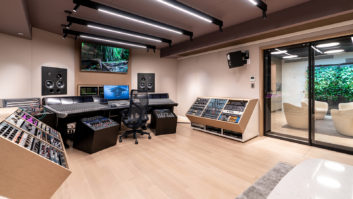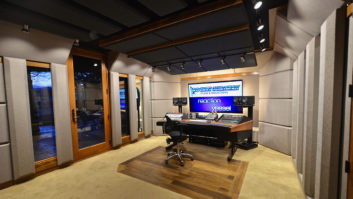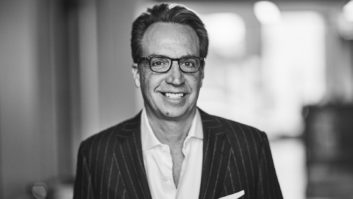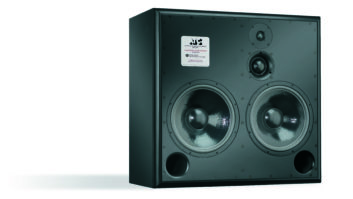One could endlessly debate the relative merits of the world’s great mastering studios and the engineers who work in them. However, few would argue that, in terms of engineering firepower and sheer scope, Sterling Sound is one of the most impressive mastering facilities ever built.
In its original incarnation — before a management buyout in 1998, and before a relocation to a new future-minded facility — Sterling was a trendsetter. Its Midtown studio featured state-of-the-art rooms and a top-flight creative staff that included Ted Jensen, Greg Calbi, Tom Coyne and George Marino.
Then, in late 1998, Jensen, Calbi and Coyne — along with businessman Murat Aktar, who would become the studio’s president — purchased Sterling from its former owner and devised a plan that was as ambitious as it was logical: to build a new mastering complex that would house six full-service, surround-ready studios, each with its own production room and client lounge. Less than four years later, Sterling completed its dream facility.
The new digs — in the thriving Chelsea Market, which spans a long block between 9th and 10th Avenues and 15th and 16th Streets — are swanky in the extreme yet comfortable and homelike, if your home happens to be a high-ceilinged New York City loft. A large, sunlit reception hall gives way to a cafeteria with a kitchenette on one side and a bank of desks on the other.
On the other side of the building are the mastering studios, which are staffed by an engineering team that is unrivaled in its ability to turn out hit after hit in musical genres ranging from pop, rock, hip hop and heavy metal to jazz, Latin music, world music and R&B: chief mastering engineer Jensen; senior mastering engineers Calbi, Coyne, Marino, Chris Gehringer and Chris Athens; and mastering engineers Steve Fallone, Dominick Maita, UE Nastasi and Michael O. Drexler. In addition, Chris Muth serves as technical director, overseeing the implementation of the equipment in every room. With so many top-notch engineers who are as talented as they are opinionated about room design, equipment and ergonomics, the design team was challenged to create a facility that would satisfy everyone’s wishes.
Led by Sterling’s Aktar, Jensen, Calbi, Coyne and Muth, the crew also included studio designer Francis Manzella, architects Julian Powell-Tuck and David Abelow, contractor Chris Bowman and electrical engineer Andrew Collins.
“We wanted the rooms to be identical for various reasons: It simplified construction and lessened the budgetary burden,” Manzella says. “If you say to a contractor, ‘Build six of these,’ they can price them modularly and buy materials accordingly. We also wanted everybody to have the same type of room so that no one would say, ‘So and so has a better room than mine.’ The rooms are very soft — not physically and acoustically, but functionally. You can move things around quite a bit without affecting the sound of the room.”
That flexibility extends to the facility’s entire studio region, which has a floated slab raised eight inches above the level of the offices and reception areas. “Clearly, the studios had to be raised for isolation, but we decided to keep everything surrounding the studios — the corridors, the walkways — raised, as well,” says Aktar. “That makes the whole facility much more flexible, because the wire troughs run along the floor and can be accessed instantly, so there’s nothing we couldn’t update in the future.”
Even for specific sessions, a room can be customized at a moment’s notice, according to Muth. “For instance, if you need to run fiber optics to get a Sonoma editor going, you pull open the floor, shove the cable in, and you’re ready to roll,” he says.
The work may seem effortless now, but relocating is never an easy project. Jensen, Calbi and their support teams moved to the new space in early 2000, and the rest of the engineers followed by the end of 2001. But a hidden benefit of making the move in two stages was that Aktar and company could fine-tune the layout of the rest of the facility even as Jensen and Calbi were working in their new rooms. The transition coincided with a period of significant growth for Sterling, with new engineers joining the staff, new formats entering the mix and the studio’s production needs growing accordingly.
“We weren’t ambitious enough in making it dense in terms of the number of rooms,” says Aktar, referring to the original plan. “The original design happened back in 1997 and 1998, before we had that much experience working together. The years that followed were real growth years for our business, when we brought in Chris Gehringer and Chris Athens and started having enormous production requirements.”
Now that the move is complete and Sterling is in a groove, Aktar and the design team marvel at how well the project turned out, notwithstanding the intense pressure under which everyone worked to get it done.
Aktar says, “I’ve never been involved in anything that when I was finished with it, I wouldn’t have changed something. To be able to break it up into manageable bits and have the experience of a couple of years in between them and be able to refine the ideas was invaluable.”







